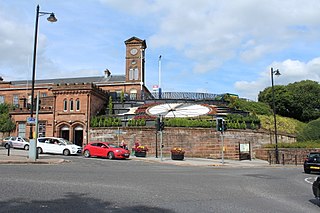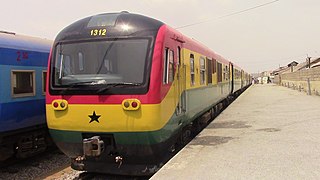
Transport in Ghana is accomplished by road, rail, air and water. Ghana's transportation and communications networks are centered in the southern regions, especially the areas in which gold, cocoa, and timber are produced. The northern and central areas are connected through a major road system.

Accra is the capital and largest city of Ghana, located on the southern coast at the Gulf of Guinea, which is part of the Atlantic Ocean. As of 2021 census, the Accra Metropolitan District, 20.4 km2 (7.9 sq mi), had a population of 284,124 inhabitants, and the larger Greater Accra Region, 3,245 km2 (1,253 sq mi), had a population of 5,455,692 inhabitants. In common usage, the name "Accra" often refers to the territory of the Accra Metropolitan District as it existed before 2008, when it covered 199.4 km2 (77.0 sq mi). This territory has since been split into 13 local government districts: 12 independent municipal districts and the reduced Accra Metropolitan District (20.4 km2), which is the only district within the capital to be granted city status. This territory of 199.4 km2 contained 1,782,150 inhabitants at the 2021 census, and serves as the capital of Ghana, while the district under the jurisdiction of the Accra Metropolitan Assembly proper (20.4 km2) is distinguished from the rest of the capital as the "City of Accra".

The West Coast Main Line (WCML) is one of the most important railway corridors in the United Kingdom, connecting the major cities of London and Glasgow with branches to Birmingham, Manchester, Liverpool and Edinburgh. It is one of the busiest mixed-traffic railway routes in Europe, carrying a mixture of intercity rail, regional rail, commuter rail and rail freight traffic. The core route of the WCML runs from London to Glasgow for 400 miles (644 km) and was opened from 1837 to 1881. With additional lines deviating to Northampton, Birmingham, Manchester, Liverpool and Edinburgh, this totals a route mileage of 700 miles (1,127 km). The Glasgow–Edinburgh via Carstairs line connects the WCML to Edinburgh. However, the main London–Edinburgh route is the East Coast Main Line. Several sections of the WCML form part of the suburban railway systems in London, Coventry, Birmingham, Manchester, Liverpool and Glasgow, with many more smaller commuter stations, as well as providing links to more rural towns.

Watford Junction is a railway station that serves Watford, Hertfordshire. The station is on the West Coast Main Line (WCML), 17 miles 34 chains (28 km) from London Euston and the Abbey Line, a branch line to St Albans. Journeys to London take between 16 and 52 minutes, depending on the service. Trains also run to Clapham Junction and East Croydon, via the West London line. The station is a major hub for local bus services and the connecting station for buses to Warner Bros. Studio Tour London – The Making of Harry Potter. The station is located north of a viaduct over the Colne valley and immediately south of Watford Tunnel.

The Glasgow Subway is an underground light metro system in Glasgow, Scotland. Opened on 14 December 1896, it is the third-oldest underground rail transit system in the world after the London Underground and the Budapest Metro. It is also one of the very few railways in the world with a track running gauge of 4 ft. Originally a cable railway, the subway was later electrified, but the double-track circular line was never expanded. The line was originally known as the Glasgow District Subway, and was thus the first mass transit system to be known as a "subway"; it was later renamed Glasgow Subway Railway. In 1936 it was renamed the Glasgow Underground. Despite this rebranding, many Glaswegians continued to refer to the network as "the Subway". In 2003, the name "Subway" was officially readopted by its operator, the Strathclyde Partnership for Transport (SPT).

Haymarket railway station is the second largest railway station in Edinburgh, Scotland, after Waverley railway station.

Tema is a city on the Bight of Benin and Atlantic coast of Ghana. It is located 25 kilometres (16 mi) east of the capital city; Accra, in the region of Greater Accra, and is the capital of the Tema Metropolitan District. As of 2013, Tema is the eleventh most populous settlement in Ghana, with a population of approximately 161,612 people – a marked decrease from its 2005 figure of 209,000. The Greenwich Meridian passes directly through the city. Tema is locally nicknamed the "Harbour City" because of its status as Ghana's largest seaport. It consists of 25 different communities which are numbered accordingly with each of them having easy access to the basic amenities.

The Greater Accra Region has the smallest area of Ghana's 16 administrative regions, occupying a total land surface of 3,245 square kilometres. This is 1.4 per cent of the total land area of Ghana. It is the most populated region, with a population of 5,455,692 in 2021, accounting for 17.7 per cent of Ghana's total population.

Darlington railway station is on the East Coast Main Line serving the town of Darlington in County Durham, England. It is 232 miles 50 chains north of London King's Cross. It is situated between Northallerton to the south and Durham to the north. Its three-letter station code is DAR.

Partick is combined National Rail and Glasgow Subway station in the Partick area of Glasgow, Scotland. Along with the adjacent bus station, it forms one of the main transport hubs in Glasgow. As of 2022, it was the fifth-busiest station in Scotland, but was overtaken in 2023. The station is served by Glasgow Subway and ScotRail services and was one of the first to receive bilingual English and Gaelic signs, due to the significant Gaelic-speaking population in the surrounding Partick area.

Ayr railway station serves the town of Ayr in South Ayrshire, Scotland. It is situated in Smith Street, off Burns Statue Square. The station, which is managed by ScotRail, is on the Ayrshire Coast Line, 41+1⁄2 miles (66.8 km) south-west of Glasgow Central.

Kilmarnock railway station is a railway station in Kilmarnock, East Ayrshire, Scotland. The station is managed by ScotRail and is served by trains on the Glasgow South Western Line. One of the earliest railway stations in Scotland, the Kilmarnock and Troon Railway opened on 6 July 1812, until it was replaced by the Glasgow, Paisley, Kilmarnock and Ayr Railway on 4 April 1843.

The Glasgow Airport Rail Link (GARL) is a proposed link between Glasgow City Centre and Glasgow Airport. The original plans for an airport rail link were proposed during the 2000s to directly link Glasgow Central station with Glasgow Airport in Scotland. The link was intended for completion by 2013 and would have had a service of four trains per hour via Paisley Gilmour Street railway station.

Ghana Railway Company Limited is the company that operates the railways of Ghana. The Ghana Railway Company Limited is a public-sector body with responsibility for the efficient management of the national rail system so as to enhance the smooth movement of goods and passengers.

The railway stations in Ghana serve a rail network concentrated in the south of the country.

The railway system in Ghana has historically been confined to the plains south of the barrier range of mountains north of the city of Kumasi. However, the 1,067 mm narrow gauge railway, totalling 1,300 kilometres, is undergoing major rehabilitation and inroads to the interior are now being made. In Ghana, most of the lines are single tracked, and in 1997 it was estimated that 32 kilometres were double tracked.

The Tema Motorway officially known as the N1 Highway is a 19-kilometre (12 mi) highway that links Tema to Accra—capital of Ghana. It is the only motorway in Ghana., is a major highway in Ghana that connects the capital city of Accra with the industrial city of Tema.
Taifa is a town in the Ga East Municipal District, a district in the Greater Accra Region of south-eastern Ghana near the capital Accra. Taifa is the twenty-sixth largest settlement in Ghana, in terms of population, with a population of 68,459 people. Taifa is located in the northwest suburbs area of Accra. It has a breakpoint on a railway line and a small park located on the northern edge of the location of the Taifa Ghana Atomic Energy Commission. At the Ghana 2000 census of 26 March 2000, the population was 26,145 inhabitants living in the city. Projections of 1 January 2007 estimated the population to be 48,927 inhabitants. In the census of 1984 there was only 1,009 inhabitants. The strong population growth of the Town is influenced by, among other things, many illegal immigrants from west African countries who move to towns and villages near the industrial town of Tema to find a job.
Bank of Africa Ghana Limited, also referred to as BOA Ghana, is a commercial bank in Ghana. It is one of the commercial banks licensed by Bank of Ghana, the central bank of Ghana, and the national banking regulator. the bank has 33 branches in 2015.

Theodore Shealtiel Clerk, was an urban planner on the Gold Coast and the first formally trained, professionally certified Ghanaian architect. Attaining a few historic firsts in his lifetime, Theodore Clerk became the chief architect, city planner, designer and developer of Tema which is the metropolis of the Tema Harbour, the largest port in Ghana. The first chief executive officer (CEO) of the Ghanaian parastatal, the Tema Development Corporation as well as a presidential advisor to Ghana's first Head of State, Kwame Nkrumah, T. S. Clerk was a founding member and the first president of the first post-independent, wholly indigenous and self-governing Ghanaian professional body, the Ghana Institute of Architects (GIA), that had its early beginnings in 1963. He was also an Associate of the Royal Institute of British Architects and the Royal Town Planning Institute.



















